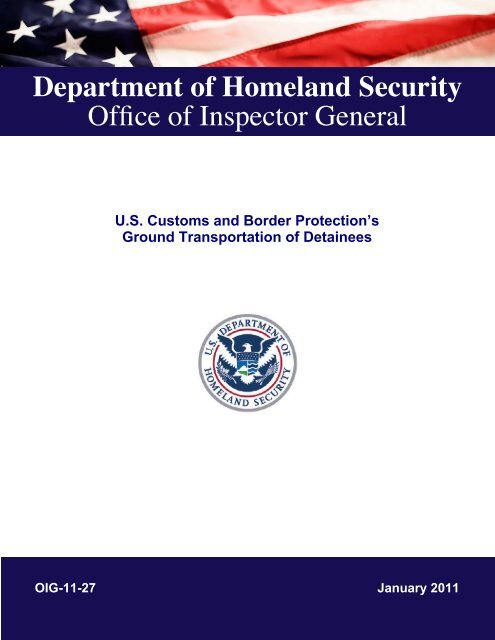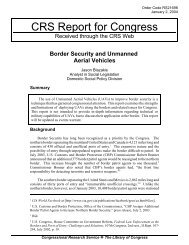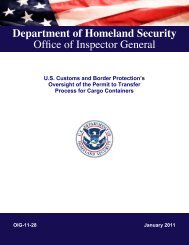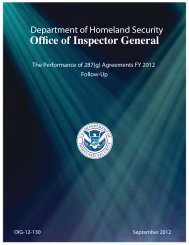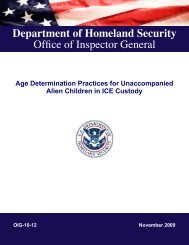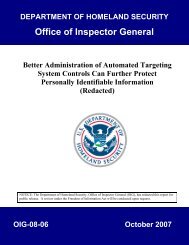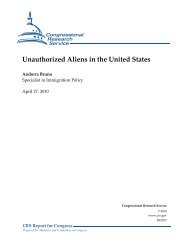US Customs and Border Protection's Ground Transportation of ...
US Customs and Border Protection's Ground Transportation of ...
US Customs and Border Protection's Ground Transportation of ...
- No tags were found...
Create successful ePaper yourself
Turn your PDF publications into a flip-book with our unique Google optimized e-Paper software.
Department <strong>of</strong> Homel<strong>and</strong> SecurityOffice <strong>of</strong> Inspector GeneralU.S. <strong>Customs</strong> <strong>and</strong> <strong>Border</strong> Protection’s <strong>Ground</strong> <strong>Transportation</strong> <strong>of</strong> Detainees OIG-11-27 January 2011
Office <strong>of</strong>Inspector GeneralU.S. Department <strong>of</strong> Homel<strong>and</strong> SecurityWashington, DC 20528JAN 11 2011Homel<strong>and</strong>SecurityPrefaceThe Department <strong>of</strong> Homel<strong>and</strong> Security (DHS) Office <strong>of</strong>Inspector General (DIG) wasestablished by the Homel<strong>and</strong> Security Act <strong>of</strong>2002 (Public Law 107-296) by amendmentto the Inspector General Act <strong>of</strong>1978. This is one <strong>of</strong> a series <strong>of</strong>audit, inspection, <strong>and</strong>special reports prepared as part <strong>of</strong>our oversight responsibilities to promote economy,efficiency, <strong>and</strong> effectiveness within the department.This report addresses the effectiveness <strong>of</strong> U.S. <strong>Customs</strong> <strong>and</strong> <strong>Border</strong> <strong>Protection's</strong> efforts tocreate a plan to provide efficient ground transportation for detainees. It is based oninterviews with employees <strong>and</strong> <strong>of</strong>ficials <strong>of</strong> relevant agencies <strong>and</strong> institutions, directobservations, <strong>and</strong> a review <strong>of</strong> applicable documents.The recommendations herein have been developed to the best knowledge available to our<strong>of</strong>fice, <strong>and</strong> have been discussed in draft with those responsible for implementation. Wetrust this report will result in more effective, efficient, <strong>and</strong> economical operations. Weexpress our appreciation to all <strong>of</strong>those who contributed to the preparation <strong>of</strong> this report.~~~Anne L. RichardsAssistant Inspector General for Audits
Table <strong>of</strong> Contents/AbbreviationsExecutive Summary.............................................................................................................1 Background..........................................................................................................................2 Results <strong>of</strong> Audit ...................................................................................................................3 CBP Does Not Have a Comprehensive Approach for Determining <strong>Transportation</strong> Needs................................................................................3 CBP Did Not Provide Adequate Oversight <strong>of</strong> the <strong>Transportation</strong> PMO.......................6 CBP Is Ill-prepared to Make Long-Term <strong>Transportation</strong> Decisions .............................7 Recommendations..........................................................................................................7 Management Comments <strong>and</strong> OIG Analysis ..................................................................8 AppendicesAppendix A: Purpose, Scope, <strong>and</strong> Methodology.......................................................11 Appendix B: Management Comments to the Draft Report.......................................13 Appendix C: Detainee <strong>Transportation</strong> Process..........................................................16 Appendix D: Major Contributors to This Report ......................................................17 Appendix E: Report Distribution ..............................................................................18 AbbreviationsCBPDHSFYICEOIGPMOU.S. <strong>Customs</strong> <strong>and</strong> <strong>Border</strong> Protection Department <strong>of</strong> Homel<strong>and</strong> Security Fiscal Year U.S. Immigration <strong>and</strong> <strong>Customs</strong> Enforcement Office <strong>of</strong> Inspector General Program Management Office
OIG Department <strong>of</strong> Homel<strong>and</strong> SecurityOffice <strong>of</strong> Inspector GeneralExecutive SummaryU.S. <strong>Customs</strong> <strong>and</strong> <strong>Border</strong> Protection is responsible for securing theNation’s borders while facilitating legitimate trade <strong>and</strong> travel. Theagency <strong>of</strong>ten requires transportation services for illegal aliensapprehended at or between U.S. ports <strong>of</strong> entry. This includesmedical escort, transport to U.S. Immigration <strong>and</strong> <strong>Customs</strong>Enforcement facilities, <strong>and</strong> transport to <strong>and</strong> from local jails <strong>and</strong>courts. Our objective was to determine whether the U.S. <strong>Customs</strong><strong>and</strong> <strong>Border</strong> Protection <strong>Transportation</strong> Program Management Officedeveloped an effective plan to provide efficient <strong>and</strong> cost effectiveground transportation for detainees.The U.S. <strong>Customs</strong> <strong>and</strong> <strong>Border</strong> Protection <strong>Transportation</strong> ProgramManagement Office has not developed an effective plan to provideefficient <strong>and</strong> cost effective ground transportation for detainees. Ithas not developed a comprehensive approach for identifying <strong>and</strong>evaluating current transportation uses <strong>and</strong> therefore has beenunable to develop a model to predict future transportationrequirements. U.S. <strong>Customs</strong> <strong>and</strong> <strong>Border</strong> Protection has not clearlydefined the scope <strong>and</strong> authority <strong>of</strong> the <strong>Transportation</strong> ProgramManagement Office or provided sufficient management <strong>and</strong>oversight <strong>of</strong> the <strong>of</strong>fice to ensure that it accomplished its mission.U.S. <strong>Customs</strong> <strong>and</strong> <strong>Border</strong> Protection has spent more than$229 million on transportation services <strong>and</strong> the <strong>Transportation</strong>Program Management Office since August 2006. Without athorough evaluation <strong>of</strong> the current uses <strong>and</strong> future requirements fortransportation services, U.S. <strong>Customs</strong> <strong>and</strong> <strong>Border</strong> Protection is illpreparedto make an informed long-term decision for transportationservices when the existing transportation contract expires in August2011.We are making two recommendations that, if implemented, wouldhelp U.S. <strong>Customs</strong> <strong>and</strong> <strong>Border</strong> Protection’s efforts in identifying<strong>and</strong> implementing comprehensive ground transportation solutions.The U.S. <strong>Customs</strong> <strong>and</strong> <strong>Border</strong> Protection concurred with bothrecommendations <strong>and</strong> has begun to formulate plans <strong>and</strong> initiateactions to address the recommendations.U.S. <strong>Customs</strong> <strong>and</strong> <strong>Border</strong> Protection’s <strong>Ground</strong> <strong>Transportation</strong> <strong>of</strong> Detainees Page 1
BackgroundU.S. <strong>Customs</strong> <strong>and</strong> <strong>Border</strong> Protection (CBP) is responsible forsecuring the Nation’s borders while facilitating legitimate trade<strong>and</strong> travel. Within CBP, the Office <strong>of</strong> Field Operations (FieldOperations) relies on <strong>Customs</strong> <strong>and</strong> <strong>Border</strong> Protection Officers(<strong>of</strong>ficers) for the security <strong>and</strong> flow <strong>of</strong> people <strong>and</strong> cargo at ports <strong>of</strong>entry, whereas the Office <strong>of</strong> <strong>Border</strong> Patrol (<strong>Border</strong> Patrol) relies on<strong>Border</strong> Patrol Agents (agents) for maintaining border securitybetween ports <strong>of</strong> entry.Field Operations <strong>and</strong> the <strong>Border</strong> Patrol <strong>of</strong>ten require transportationservices. These services include transporting illegal aliensapprehended at or between the ports <strong>of</strong> entry to medical facilities,to U.S. Immigration <strong>and</strong> <strong>Customs</strong> Enforcement (ICE) facilities,<strong>and</strong> to <strong>and</strong> from local jails <strong>and</strong> courts. Appendix C contains moredetails on the transportation <strong>of</strong> detainees.In 2004, the Undersecretary for <strong>Border</strong> <strong>and</strong> <strong>Transportation</strong>Security issued a memor<strong>and</strong>um instructing that the apprehendingagency is responsible for all costs associated with the care <strong>and</strong>custody <strong>of</strong> aliens until they are turned over to ICE. ICE initiallyprovided CBP with 170 agents to perform transportation services.In 2006, ICE recalled its agents to comply with the memor<strong>and</strong>um.In August 2006, CBP awarded a transportation contract thatprovided support to CBP sectors <strong>and</strong> ports along the Southwest<strong>Border</strong>. The 5-year contract was intended as a stopgap measure toallow the agency the opportunity to identify alternative solutionsduring a transition period. The initial budget for the contract was$50 million, funded through an interagency agreement with ICE.In March 2007, the Secure <strong>Border</strong> Initiative created the detainee<strong>Transportation</strong> Program Management Office (PMO) to oversee thedetainee transportation contract <strong>and</strong> develop a more efficienttransportation solution at <strong>and</strong> between border ports <strong>of</strong> entry. Infiscal year (FY) 2008, the budget for the contract <strong>and</strong> the<strong>Transportation</strong> PMO was $75 million, which increased to$83 million per year in FYs 2009 <strong>and</strong> 2010.In 2008, the Secure <strong>Border</strong> Initiative approved the <strong>Transportation</strong>PMO’s charter, which tasked the <strong>of</strong>fice to implement newtransportation capabilities through any mix <strong>of</strong> in-house, contract,or reimbursable support resources. The charter explains that the<strong>Transportation</strong> PMO is responsible for assisting Field OperationsU.S. <strong>Customs</strong> <strong>and</strong> <strong>Border</strong> Protection’s <strong>Ground</strong> <strong>Transportation</strong> <strong>of</strong> Detainees Page 2
support, hiring additional <strong>of</strong>ficers <strong>and</strong> agents to perform thetransportation duties, <strong>and</strong> creating a new type <strong>of</strong> position <strong>and</strong>hiring detention enforcement <strong>of</strong>ficers 1 to perform transportationduties. The <strong>Transportation</strong> PMO presented these options to theExecutive Coordinating Council, an overarching group establishedto review integration <strong>of</strong> detainee transportation <strong>and</strong> related guardservices for Field Operations <strong>and</strong> <strong>Border</strong> Patrol, showing thereplacement contract as the low cost alternative. However, the<strong>Transportation</strong> PMO did not adequately evaluate <strong>and</strong> present thecosts associated with these options to identify the optimal solutionsfor transportation requirements.Our review <strong>of</strong> the information the <strong>Transportation</strong> PMO provided tothe Executive Coordinating Council showed that the<strong>Transportation</strong> PMO:• Did not have adequate support for its estimate <strong>of</strong> futuretransportation requirements;• Overstated the cost <strong>of</strong> the detention enforcement <strong>of</strong>ficerposition by $89 million;• Overstated the cost <strong>of</strong> hiring additional <strong>of</strong>ficers <strong>and</strong> agentsby $75 million; <strong>and</strong>• Understated contract costs by $22 million.The <strong>Transportation</strong> PMO used CBP’s FY 2011 budget model as abasis for the life cycle cost estimate <strong>of</strong> the detention enforcement<strong>of</strong>ficer position as well as the costs for CBP <strong>of</strong>ficers <strong>and</strong> agents. Incontrast, the <strong>of</strong>fice used FY 2009 actual expenses adjusted forinflation as a basis for the contract alternative.We reviewed these models <strong>and</strong> identified that the <strong>Transportation</strong>PMO included inappropriate costs for each government employee 2for personal compensation awards, relocation, long-distance phonecalls, <strong>and</strong> recruitment expenses, which were not included for thecontractor. The <strong>Transportation</strong> PMO overstated the detentionenforcement <strong>of</strong>ficer option by using an inflated grade level. Inaddition, the <strong>Transportation</strong> PMO understated the contract costs byexcluding the amounts spent on continuous contract support <strong>and</strong>oversight.1A Detention Enforcement Officer would be a newly formed position within CBP, focused primarily ontransportation functions. The position would also be able to provide support for additional activities asneeded by CBP. This position would not have the full law enforcement responsibilities <strong>of</strong> a CBP agent or<strong>of</strong>ficer <strong>and</strong> would use a lower pay structure.2 This includes the proposed detention enforcement <strong>of</strong>ficer <strong>and</strong> additionally hired <strong>of</strong>ficers <strong>and</strong> agents.U.S. <strong>Customs</strong> <strong>and</strong> <strong>Border</strong> Protection’s <strong>Ground</strong> <strong>Transportation</strong> <strong>of</strong> Detainees Page 5
The <strong>Transportation</strong> PMO also included overhead expenses alreadyincurred by the government such as General ServicesAdministration rental payments, utilities, <strong>and</strong> shipping fees thatshould not significantly increase with the addition <strong>of</strong> the detentionenforcement <strong>of</strong>ficer position.CBP Did Not Provide Adequate Oversight <strong>of</strong> the <strong>Transportation</strong>PMOThe agency has not provided adequate management <strong>and</strong> oversightfor the <strong>Transportation</strong> PMO. CBP did not provide criteria thatclearly defined the scope, authority, or performance expectations<strong>of</strong> the <strong>of</strong>fice. Without establishing performance expectations <strong>and</strong>monitoring the <strong>Transportation</strong> PMO’s execution <strong>of</strong> its mission,CBP was not able to ensure that the <strong>of</strong>fice identified <strong>and</strong> presentedappropriate future solutions for transportation requirements.<strong>Transportation</strong> PMO Not Following its CharterCBP has not ensured that the <strong>Transportation</strong> PMO is fulfilling itsmission as defined in its charter. The charter establishes the<strong>of</strong>fice’s overall mission broadly in some sections, yet narrows itsfunctions <strong>and</strong> responsibilities to contract-related tasks in others.For example, the charter tasks the <strong>Transportation</strong> PMO to assistField Operations <strong>and</strong> <strong>Border</strong> Patrol sponsors to gather, analyze,validate, <strong>and</strong> prioritize operational requirements <strong>and</strong> ensure thattransportation solutions meet end users’ requirements. Yet itfurther defines the scope <strong>of</strong> the <strong>Transportation</strong> PMO to:• Provide oversight <strong>and</strong> visibility <strong>of</strong> current contract service.• Develop an integrated system <strong>of</strong> detainee transportation,security, <strong>and</strong> administrative support.• Implement short-term <strong>and</strong> stopgap strategies pendingdevelopment <strong>of</strong> long-term capabilities.• Identify acquisition strategies that provide transportationsolutions.The <strong>Transportation</strong> PMO selected what functions it performed <strong>and</strong>limited its focus to the contract in place <strong>and</strong> planning for a followoncontract. <strong>Transportation</strong> PMO leadership explained that theybelieved theirs was an acquisition management <strong>of</strong>fice with limitedinfluence over CBP operations affecting <strong>of</strong>ficers <strong>and</strong> agents. The<strong>Transportation</strong> PMO Director believes the <strong>of</strong>fice cannot imposeU.S. <strong>Customs</strong> <strong>and</strong> <strong>Border</strong> Protection’s <strong>Ground</strong> <strong>Transportation</strong> <strong>of</strong> Detainees Page 6
changes outside <strong>of</strong> the transportation contract <strong>and</strong> should thereforelimit itself to a narrow contract management role.CBP did not establish clear performance expectations to evaluatethe <strong>Transportation</strong> PMO. The <strong>Transportation</strong> PMO establishedfive performance goals for FY 2010, but none <strong>of</strong> the goalsaddressed how effectively the <strong>Transportation</strong> PMO program metthe missions defined in its charter. Additionally, the five goalswere not measurable <strong>and</strong> were limited to acquisition compliance<strong>and</strong> contract management. The CBP <strong>of</strong>ficial responsible foroverseeing the <strong>Transportation</strong> PMO acknowledged that heassumed that the <strong>of</strong>fice was functioning as intended withoutperforming close oversight to ensure that it met its mission.CBP Is Ill-prepared to Make Long-term <strong>Transportation</strong>DecisionCBP is ill-prepared to make a long-term decision for detaineetransportation. CBP has invested more than $291 million in the<strong>Transportation</strong> PMO <strong>and</strong> its activities to implement more efficientground transportation solutions. However, the agency has noassurance that the optimal transportation solution has beenidentified to meet future requirements. Without completeinformation <strong>and</strong> analysis, CBP does not know if its <strong>of</strong>ficers <strong>and</strong>agents perform excessive collateral transportation services or if theagency’s plans to award a new contract for transportation serviceswill meet its needs efficiently.The agency plans to invest an estimated $400 million over 5 yearsfor transportation solutions when the current contract ends inAugust 2011. Before CBP makes this investment, it should ensurethat the <strong>Transportation</strong> PMO clearly identifies CBP’stransportation needs with a thorough analysis <strong>of</strong> alternatives tosupport the most cost effective long-term solution.RecommendationsWe recommend that the Chief, U.S. <strong>Border</strong> Patrol <strong>and</strong> theAssistant Commissioner, Office <strong>of</strong> Field Operations:Recommendation #1: Establish a methodology to identify currenttransportation requirements, create a model to predict futureU.S. <strong>Customs</strong> <strong>and</strong> <strong>Border</strong> Protection’s <strong>Ground</strong> <strong>Transportation</strong> <strong>of</strong> Detainees Page 7
equirements, <strong>and</strong> identify the optimal mix <strong>of</strong> resources to meetthose requirements.Recommendation #2: Provide sufficient management <strong>and</strong>oversight to ensure accountability for performing the analysis <strong>of</strong>current <strong>and</strong> future transportation needs.Management Comments <strong>and</strong> OIG AnalysisCBP concurred with both <strong>of</strong> the recommendations in the report <strong>and</strong>the agency has already begun to formulate plans <strong>and</strong> initiateactions to address the recommendations. CBP expressed concernthat the report does not acknowledge some <strong>of</strong> the significant effortson the part <strong>of</strong> the <strong>Transportation</strong> PMO, thereby negatively skewingthe balance <strong>and</strong> tone <strong>of</strong> the report. We recognize the PMO’sefforts; however, the agency’s <strong>of</strong>ficial response provided generalstatements without the documentation <strong>and</strong> evidence to refute themessage <strong>of</strong> our report. CBP explained that the PMO adhered tothe DHS acquisition program management policy <strong>and</strong> guidance<strong>and</strong> used an approved Analysis <strong>of</strong> Alternatives Study Plan to guidetheir cost benefit analysis. While CBP may have used theapproved Study Plan, the draft report identifies internal controlweaknesses with CBP’s approach to determining its transportationneeds. Specifically, the <strong>Transportation</strong> PMO did not establish aprocess to identify, analyze, or validate comprehensivetransportation needs. We continue to assert this is necessaryinformation to use as a foundation for a realistic cost analysis.CBP disagreed with the OIG’s conclusion that the <strong>Transportation</strong>PMO overstated the cost <strong>of</strong> the detention enforcement <strong>of</strong>ficer <strong>and</strong>the cost <strong>of</strong> hiring additional Office <strong>of</strong> Field Operations <strong>of</strong>ficers <strong>and</strong><strong>Border</strong> Patrol agents. The agency noted that even if all costadjustments recommended by the OIG were made, the five yearestimates would not change the fact that contracting is still the lowcost alternative. The OIG reviewed all documentation provided bythe PMO, held meetings with the PMO to discuss the cost analysismethodology, <strong>and</strong> briefed PMO management on multipleoccasions. Our report does not disagree that using a transportationcontract may be the lowest cost option, but emphasizes the absence<strong>of</strong> basic data elements <strong>and</strong> unnecessary overhead expenses makesthe cost analysis unreliable for CBP to make an informed longtermtransportation decision. The OIG team attempted to furtherdiscuss <strong>and</strong> gather evidence to support CBP’s position; however,U.S. <strong>Customs</strong> <strong>and</strong> <strong>Border</strong> Protection’s <strong>Ground</strong> <strong>Transportation</strong> <strong>of</strong> Detainees Page 8
the agency cancelled the meeting <strong>and</strong> did not provide additionalsupporting documentation.CBP expressed concern with the OIG’s conclusion that the agencyhas not provided adequate oversight to the <strong>Transportation</strong> PMO.Our conclusion is based on the absence <strong>of</strong> specific criteria thatclearly defined the scope, authority, or performance expectations<strong>of</strong> the <strong>of</strong>fice, leaving the PMO to limit its focus to the contract inplace <strong>and</strong> planning for a follow-on contract <strong>and</strong> not managing thecomprehensive transportation program.We consider the recommendations unresolved <strong>and</strong> open until moreinformation is provided. CBP’s response also included technicalcomments which provided additional details <strong>and</strong> clarification thatwas unavailable at the time <strong>of</strong> our fieldwork. We considered thesecomments when preparing the final report <strong>and</strong>, where appropriate,modified the report. A summary <strong>of</strong> the recommendations <strong>and</strong>CBP’s actions to address the recommendations follows.Management Response to Recommendation #1:CBP concurred: CBP agreed with the need to establish amethodology to identify current transportation requirements, createa model to predict future requirements, <strong>and</strong> identify the optimalmix <strong>of</strong> resources to meet those requirements. The agencyconfirmed that the ideal data collection methodology wouldinclude activity-based data captured real or near real time. Thedata would be verified <strong>and</strong> validated, <strong>and</strong> made available todecision makers on a timely basis. The method must integratecollection activity between <strong>Border</strong> Patrol <strong>and</strong> Field Operationswhose operations are substantially different from each other. Itmust identify <strong>and</strong> accurately allocate the correct time <strong>and</strong> resourcesspent on multiple, but concurrent activities such as line watch <strong>and</strong>transporting apprehended aliens.CBP plans to assess the cost <strong>and</strong> feasibility <strong>of</strong> a system with theneed to minimize operational impact <strong>and</strong> increase effectiveness<strong>and</strong> efficiency. In the meantime, <strong>Border</strong> Patrol <strong>and</strong> FieldOperations have begun a process <strong>of</strong> collecting requirements fromdata calls <strong>and</strong> survey instruments. The data will be verified <strong>and</strong>validated by comparing existing databases <strong>and</strong> prior submissions.The agency will also collect data from a modified r<strong>and</strong>omsampling <strong>of</strong> locations that transport a high number <strong>of</strong> aliens toindependently validate data. CBP indicated that the PMO has beenusing several modeling approaches developed by a contractor toU.S. <strong>Customs</strong> <strong>and</strong> <strong>Border</strong> Protection’s <strong>Ground</strong> <strong>Transportation</strong> <strong>of</strong> Detainees Page 9
analyze transportation routes to determine the optimal mix <strong>of</strong>staffing resources such as detention enforcement <strong>of</strong>ficers,contractors, <strong>and</strong> CBP personnel. CBP will collect data morefrequently to reduce error <strong>and</strong> improve data quality. The agencyplans to complete a feasibility study by June 30, 2012.OIG Analysis: We appreciate CBP’s efforts to move towards adata collection methodology would include activity-based datacaptured real or near real time. Although CBP has beguncollecting more information <strong>and</strong> agreed to conduct a feasibilitystudy to assess the cost <strong>and</strong> feasibility <strong>of</strong> such a system, the agencydid not provide sufficient details on its effort <strong>and</strong> commitment toidentify accurate transportation requirements create a model topredict future requirements, <strong>and</strong> identify the optimal mix <strong>of</strong>resources. This recommendation is unresolved <strong>and</strong> will remainopen.Management Response to Recommendation #2:CBP concurred: CBP responded that management oversight toprovide guidance <strong>and</strong> to ensure accountability for accuratelydetermining current <strong>and</strong> future transportation needs is important.The agency agreed to provide more management <strong>and</strong> oversight toensure accountability for performing the analysis <strong>of</strong> current <strong>and</strong>future transportation needs. CBP indicated that <strong>Border</strong> Patrolprovided oversight <strong>of</strong> the <strong>Transportation</strong> Office, but acknowledgedthe <strong>of</strong>fice could do more to improve management oversight. CBPwill review the charters for the PMO <strong>and</strong> the ECC <strong>and</strong> makerevisions to better define the scope <strong>of</strong> the PMO <strong>and</strong> clarify theroles <strong>and</strong> responsibilities <strong>of</strong> each no later than April 30, 2011.CBP has recently established a Component Acquisition Executiveto provide acquisition oversight <strong>of</strong> the <strong>Transportation</strong> program <strong>and</strong>similar programs. This management oversight will include aquarterly program review with the Component AcquisitionExecutive beginning no later than March 31, 2011.OIG Analysis: This recommendation is unresolved <strong>and</strong> willremain open. We recognize CBP’s efforts to provide acquisitionoversight <strong>of</strong> the <strong>Transportation</strong> program; however, more details areneeded to underst<strong>and</strong> how <strong>Border</strong> Patrol will improve managementoversight. We also need to review all modifications made to thePMO <strong>and</strong> ECC charters to ensure the intent <strong>of</strong> the recommendationis satisfied.U.S. <strong>Customs</strong> <strong>and</strong> <strong>Border</strong> Protection’s <strong>Ground</strong> <strong>Transportation</strong> <strong>of</strong> Detainees Page 10
Appendix APurpose, Scope, <strong>and</strong> MethodologyOur objective was to determine whether the U.S. <strong>Customs</strong> <strong>and</strong><strong>Border</strong> Protection (CBP) <strong>Transportation</strong> Program ManagementOffice (PMO) developed an effective plan to provide efficient <strong>and</strong>cost effective ground transportation for detainees.To accomplish our objective, we reviewed <strong>and</strong> analyzed applicablelaws <strong>and</strong> regulations; prior audit reports; CBP documentationestablishing <strong>and</strong> managing the <strong>Transportation</strong> PMO, ExecutiveCoordinating Council, <strong>and</strong> Integrated Project Team outputs; <strong>and</strong>contract documents related to transportation services from August2006 through August 2010.We interviewed CBP headquarters personnel from the Secure<strong>Border</strong> Initiative, Field Operations, <strong>and</strong> <strong>Border</strong> Patrol, includingstaff from the <strong>Transportation</strong> PMO. We also spoke with personnelfrom the Office <strong>of</strong> <strong>Border</strong> Patrol Workforce Management, Finance<strong>and</strong> Logistics branches, CBP Acquisition <strong>and</strong> ProgramManagement Offices, as well as personnel from <strong>Transportation</strong>PMO contractor companies.We analyzed cost models that the <strong>Transportation</strong> PMO used toestimate contract <strong>and</strong> CBP alternatives to support long-termtransportation decisions. We also reviewed analysis performed by<strong>Transportation</strong> PMO contractors that the <strong>of</strong>fice included in its costmodels. We reviewed data from apprehension <strong>and</strong> timekeepingsystems to see whether they contained information that CBP coulduse to determine transportation needs.We selected <strong>and</strong> visited field locations in California <strong>and</strong> Arizonabased on high rates <strong>of</strong> apprehensions <strong>and</strong> border-crossing statistics.We toured one <strong>Border</strong> Patrol station <strong>and</strong> two ports <strong>of</strong> entry in SanDiego, CA, <strong>and</strong> two <strong>Border</strong> Patrol stations <strong>and</strong> two ports <strong>of</strong> entryin Tucson, AZ. We also visited the <strong>Border</strong> Patrol <strong>and</strong> FieldOperations headquarters <strong>of</strong>fices in both locations. During thesevisits, we spoke with field personnel, including chiefs, shiftsupervisors, <strong>and</strong> agents at <strong>Border</strong> Patrol stations <strong>and</strong> at <strong>Border</strong>Patrol sectors. We spoke with port directors, watch comm<strong>and</strong>ers,<strong>and</strong> CBP <strong>of</strong>ficers at ports <strong>of</strong> entry <strong>and</strong> Field Operations <strong>of</strong>fices.We conducted this performance audit between April <strong>and</strong>September 2010 under the authority <strong>of</strong> the Inspector General Act<strong>of</strong> 1978, as amended, <strong>and</strong> according to generally acceptedgovernment auditing st<strong>and</strong>ards. Those st<strong>and</strong>ards require that weplan <strong>and</strong> perform the audit to obtain sufficient, appropriateevidence to provide a reasonable basis for our findings <strong>and</strong>U.S. <strong>Customs</strong> <strong>and</strong> <strong>Border</strong> Protection’s <strong>Ground</strong> <strong>Transportation</strong> <strong>of</strong> Detainees Page 11
Appendix APurpose, Scope, <strong>and</strong> Methodologyconclusions based on our audit objectives. We believe theevidence obtained provides a reasonable basis for our findings <strong>and</strong>conclusions based on our audit objectives.U.S. <strong>Customs</strong> <strong>and</strong> <strong>Border</strong> Protection’s <strong>Ground</strong> <strong>Transportation</strong> <strong>of</strong> Detainees Page 12
Appendix BManagement Comments to the Draft Report1300 ""nllsylvmi~ A"enue!':WW~lhillglon. DC 20229~~u.s. <strong>Customs</strong> ilnd<strong>Border</strong> ProtectionDccemher 13,2010MEMORANDUM FOR RICHARD L. SKINNERINSPECTOR GENERALDI::PARTMENT OF IIOMELAND SECURITYFROM: Assistant Commissioner ~ ..... 1 --o:reDs QOffice <strong>of</strong> Internal Affairs cr--~' tSUBJECT:U.s. <strong>Customs</strong> <strong>and</strong> <strong>Border</strong> Prot~tion's Response to the Office <strong>of</strong> InspectorGeneral's Draft Re]Xlrt Entitled, "U.S. <strong>Customs</strong> <strong>and</strong> <strong>Border</strong> <strong>Protection's</strong><strong>Ground</strong> <strong>Transportation</strong> <strong>of</strong> Detainees Program"Thank you for providing us with a copy <strong>of</strong> your draft report entitled ··U.S. <strong>Customs</strong> <strong>and</strong> <strong>Border</strong>Protl~tion's <strong>Ground</strong> <strong>Transportation</strong> <strong>of</strong> Detainees Program." dated November 2010. We appreciate theopportunity to revie\\ <strong>and</strong> respond to the report. The report llddresses the effectiveness <strong>of</strong> U.S.<strong>Customs</strong> <strong>and</strong> <strong>Border</strong> <strong>Protection's</strong> (CBI') efforts to create a plan to provide efficient groundtransportation for detainees.After careful review, we believe the draft report docs not acknowledge some <strong>of</strong> the significant cffortson the part <strong>of</strong>the <strong>Transportation</strong> Program Management Office (1'11.10). thereby negativel) skewing thebalance <strong>and</strong> tone <strong>of</strong> the report. For example. the Office <strong>of</strong> Inspector General (O[G) concluded thatCBp docs not have a comprehensive approlleh for determining transportation needs lind that COP didnot provide adequate oversight <strong>of</strong>the Tr.msportation PMO. The <strong>Transportation</strong> PMO adhered t<strong>of</strong>)epartmenl <strong>of</strong>llomcl<strong>and</strong> Security (DHS) acquisition program management policy <strong>and</strong> guidance. Insupport orlhis process. the <strong>Transportation</strong> I'MO developed an Analysis <strong>of</strong> Alternatives (AoA) Stud}Plan that \,as endorsed by the Executiv
Appendix BManagement Comments to the Draft ReportFinancial Olf>C< CRp O[fioi< T'""'I""!a1ion "MO ",pIoml ..'''i,.d.,''' lItWl d< oorncI '''"'' <strong>and</strong> '""""'" _ 0
Appendix BManagement Comments to the Draft ReportKuomm!ldlljoa n, Pro> ,nag ...bDIino'''i
Appendix CDetainee <strong>Transportation</strong> ProcessField to <strong>Border</strong> Patrol Station: <strong>Transportation</strong>s usually conducted by <strong>Border</strong> Patrolagents from locations between the ports <strong>of</strong> entry near the border or from checkpointsestablished on known egress routes.Port <strong>of</strong> Entry or <strong>Border</strong> Patrol Station to Detention <strong>and</strong> Removal Facilities:<strong>Transportation</strong> conducted by CBP <strong>of</strong>ficers <strong>and</strong> agents after the detainee has beenprocessed <strong>and</strong> a final disposition <strong>of</strong> the detainee has been determinedPort <strong>of</strong> Entry or <strong>Border</strong> Patrol Station to Other: <strong>Transportation</strong>s conducted by CBP<strong>of</strong>ficers <strong>and</strong> agents after the detainee has been apprehended at a port <strong>of</strong> entry ortransported to a <strong>Border</strong> Patrol station, but before the detainee has been processed or afinal disposition <strong>of</strong> the detainee has been determined.U.S. <strong>Customs</strong> <strong>and</strong> <strong>Border</strong> Protection’s <strong>Ground</strong> <strong>Transportation</strong> <strong>of</strong> Detainees Page 16
Appendix DMajor Contributors to This ReportPatrick O’Malley, DirectorChristine Haynes, Audit ManagerJeanette Hyatt, Auditor in ChargeJacque Bear, Program AnalystJohn Jadick, Program AnalystKeith Lutgen, Program AnalystThomas Bobrowski, Independent ReferencerU.S. <strong>Customs</strong> <strong>and</strong> <strong>Border</strong> Protection’s <strong>Ground</strong> <strong>Transportation</strong> <strong>of</strong> Detainees Page 17
Appendix EReport DistributionDepartment <strong>of</strong> Homel<strong>and</strong> SecuritySecretaryDeputy SecretaryChief <strong>of</strong> StaffDeputy Chief <strong>of</strong> StaffGeneral CounselExecutive SecretariatDirector, GAO/OIG Liaison OfficeAssistant Secretary for Office <strong>of</strong> PolicyAssistant Secretary for Office <strong>of</strong> Public AffairsAssistant Secretary for Office <strong>of</strong> Legislative AffairsU.S. <strong>Customs</strong> <strong>and</strong> <strong>Border</strong> ProtectionCommissionerChief, U.S. <strong>Border</strong> PatrolAssistant Commissioner, Office <strong>of</strong> Field OperationsOIG LiaisonOffice <strong>of</strong> Management <strong>and</strong> BudgetChief, Homel<strong>and</strong> Security BranchDHS OIG Budget ExaminerCongressCongressional Oversight <strong>and</strong> Appropriations Committees, asappropriateU.S. <strong>Customs</strong> <strong>and</strong> <strong>Border</strong> Protection’s <strong>Ground</strong> <strong>Transportation</strong> <strong>of</strong> Detainees Page 18
ADDITIONAL INFORMATION AND COPIESTo obtain additional copies <strong>of</strong> this report, please call the Office <strong>of</strong> Inspector General (OIG) at (202) 254-4100,fax your request to (202) 254-4305, or visit the OIG web site at www.dhs.gov/oig.OIG HOTLINETo report alleged fraud, waste, abuse or mismanagement, or any other kind <strong>of</strong> criminal or noncriminalmisconduct relative to department programs or operations:• Call our Hotline at 1-800-323-8603;• Fax the complaint directly to us at (202) 254-4292;• Email us at DHSOIGHOTLINE@dhs.gov; or• Write to us at:DHS Office <strong>of</strong> Inspector General/MAIL STOP 2600,Attention: Office <strong>of</strong> Investigations - Hotline,245 Murray Drive, SW, Building 410,Washington, DC 20528.The OIG seeks to protect the identity <strong>of</strong> each writer <strong>and</strong> caller.


